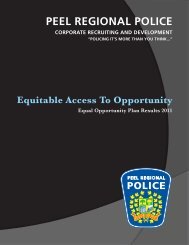What is CPTED? - Peel Regional Police
What is CPTED? - Peel Regional Police
What is CPTED? - Peel Regional Police
Create successful ePaper yourself
Turn your PDF publications into a flip-book with our unique Google optimized e-Paper software.
<strong>What</strong> <strong>is</strong> <strong>CPTED</strong><br />
By: Cst. Tom McKay<br />
<strong>CPTED</strong> (pronounced sep-ted) <strong>is</strong> a short form for the proactive crime fighting technique known as Crime<br />
Prevention Through Environmental Design.<br />
<strong>CPTED</strong> Is Based Upon The Theory That:<br />
"the proper design and effective use of the built environment can lead to a reduction in the incidence<br />
and fear of crime, and an improvement in the quality of life".<br />
<strong>CPTED</strong>'S underlying objective <strong>is</strong> to help the various d<strong>is</strong>ciplines do a better job of achieving their primary objectives, with the<br />
added by-product of improved security and loss prevention. Th<strong>is</strong> objective <strong>is</strong> based upon the belief that crime and loss <strong>is</strong> a<br />
by-product of human functions that are not working.<br />
How Does <strong>CPTED</strong> Differ From Traditional Crime Fighting Techniques<br />
<strong>CPTED</strong>'s emphas<strong>is</strong> <strong>is</strong> based on design and use. In th<strong>is</strong> way, it deviates from the traditional target hardening approach to<br />
crime prevention.<br />
The target-hardening approach traditionally focused on denying access to a crime target through physical or artificial barriers<br />
(such as locks, alarms, fences and gates). Th<strong>is</strong> approach often overlooked the opportunities for natural access control and<br />
surveillance while placing a constraint on the use, access and enjoyment of the hardened environment.<br />
<strong>CPTED</strong> emphasizes and exploits these lost opportunities through the development of three overlapping <strong>CPTED</strong> strategies.<br />
These strategies are:<br />
• Natural Surveillance<br />
• Natural Access Control<br />
• Territorial Reinforcement<br />
Natural Surveillance<br />
Natural Access Control<br />
Territorial Reinforcement<br />
<strong>is</strong> a design strategy that <strong>is</strong> directed primarily at keeping intruders under observation.<br />
<strong>is</strong> a design strategy that <strong>is</strong> directed at decreasing crime opportunity.<br />
<strong>is</strong> a design strategy that realizes that physical design can create or extend a sphere of influence<br />
so that users develop a sense of proprietorship or territoriality.<br />
The term "natural" refers to deriving surveillance and access control as a by-product of the normal and routine use of the<br />
environment. Natural surveillance and access control can be ultimately subdivided into three categories. These are natural,<br />
mechanical, and organized means.<br />
Mechanical forms of natural surveillance and access control commonly use traditional target hardening techniques. The use<br />
of these techniques are limited to situations where the effective use of the environment <strong>is</strong> not unduly impaired.<br />
How Can We Assess Which Strategies Are Needed<br />
To assess which strategies are needed, we must first assess the space we are evaluating. To do th<strong>is</strong> we use what has been<br />
referred to as the three D approach. Th<strong>is</strong> approach <strong>is</strong> based upon the following functions:<br />
• All human space has some DESIGNATED purpose.<br />
• All human space has social, cultural, legal or physical DEFINITIONS that prescribe the desired and<br />
acceptable behaviours.<br />
• All human space <strong>is</strong> DESIGNED to support and control the desired behaviour.<br />
1
<strong>What</strong> <strong>is</strong> <strong>CPTED</strong><br />
The 3 D's of Designation, Definition and Design may be used as a guide to the evaluation of space, by asking the following<br />
types of questions:<br />
Designation<br />
• <strong>What</strong> <strong>is</strong> the designated purpose of th<strong>is</strong> space<br />
• <strong>What</strong> was it originally intended to be used for<br />
• How well does the space support its current use Its intended use<br />
• Is there conflict<br />
Definition<br />
• How <strong>is</strong> the space defined<br />
• Is it clear who owns it<br />
• Where are its borders<br />
• Are there social or cultural definitions that affect how that space <strong>is</strong> used<br />
• Are the legal or admin<strong>is</strong>trative rules clearly set out and reinforced in policy<br />
• Are there signs<br />
• Is there conflict or confusion between the designated purpose and definition<br />
Design<br />
• How well does the physical design support the intended function<br />
• How well does the physical design support the definition of the desired or accepted behaviours<br />
• Does the physical design conflict with or impede the productive use of the space or the proper functioning of<br />
the intended human activity<br />
• Is there confusion or conflict in the manner in which the physical design <strong>is</strong> intended to control behaviour<br />
These questions are reflective of the <strong>CPTED</strong> priorities of questioning everything while looking at things from a different<br />
perspective and never the same way again.<br />
Once we have completed our assessment we can begin to match the d<strong>is</strong>cipline's functions with a space that can support them.<br />
It <strong>is</strong> at th<strong>is</strong> stage where we will begin to apply the <strong>CPTED</strong> strategies that were noted above.<br />
Where Can <strong>CPTED</strong> Be Applied<br />
<strong>CPTED</strong> <strong>is</strong> so versatile it can literally be applied anywhere. However, some of the areas that have already benefitted from<br />
<strong>CPTED</strong> are:<br />
• Shopping malls and parking areas<br />
• Industrial/Commercial parks<br />
• Schools and institutions<br />
• Parks and play grounds<br />
• Housing developments<br />
• Street systems and Marinas<br />
Are there common <strong>CPTED</strong> design strategies<br />
YES. Nine major <strong>CPTED</strong> strategies are l<strong>is</strong>ted below:<br />
1. Provide clear border definition of controlled space.<br />
2. Provide clearly marked transitional zones which indicated movement from semi-public to private space.<br />
2
<strong>What</strong> <strong>is</strong> <strong>CPTED</strong><br />
3. Relocate gathering areas to locations with natural surveillance and access control or to locations away from the view<br />
of would be offenders.<br />
4. Place safe activities in unsafe locations to increase the natural surveillance of these locations. Th<strong>is</strong> will increase the<br />
perception of safety within these areas while increasing the perception of r<strong>is</strong>k in offenders.<br />
5. Place unsafe activities in safe spots to overcome the vulnerability of these activities with the natural surveillance and<br />
access control of the safe area.<br />
6. Redesignate the use of space to provide natural barriers to conflicting activities.<br />
7. Improve scheduling of space to allow for effective use and appropriate critical intensity.<br />
8. Redesign space to increase the perception or reality of natural surveillance.<br />
9. Overcome d<strong>is</strong>tance and <strong>is</strong>olation through improved communications and design efficiencies.<br />
The <strong>CPTED</strong> philosophy <strong>is</strong> perhaps best summed up by the <strong>CPTED</strong> motto:<br />
"<strong>What</strong> are you trying to do here, and how can we help you do it better"<br />
If th<strong>is</strong> motto <strong>is</strong> followed we can expect to meet the objectives of <strong>CPTED</strong> and the objectives of community policing.<br />
Bibliography<br />
Crowe, Timothy, D., Crime Prevention Through Environmental Design: Applications of Architectural Design and Space<br />
Management Concepts. Lou<strong>is</strong>ville, KY., National Crime Prevention Institute, 1991.<br />
3















